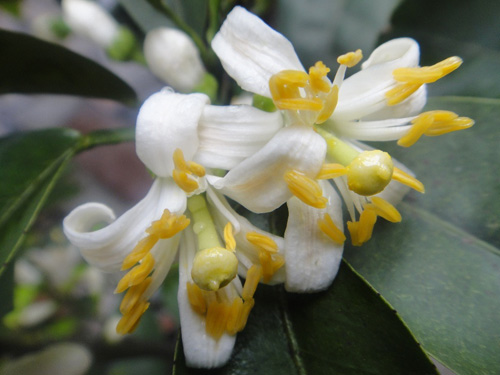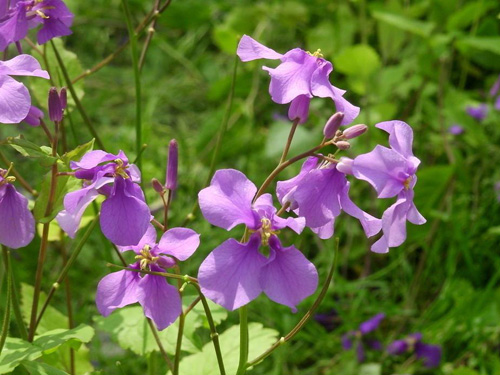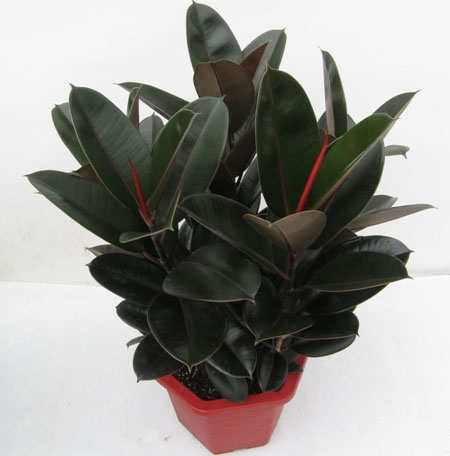Culture methods of generations of flowers
Generation (citrus aurantium)
Alias: daidai, fruit of generation, flower of generation, smelly orange, lime, green orange
Families and genera: Rutaceae, citrus
Morphological features: evergreen shrub. Branches sparsely short spines, twigs angular. The trunk bark is green with volatile oil glands. Leaves alternate, leathery, elliptic to ovate-elliptic, apex acuminate, margin undulate notched, base cuneate, veins obvious. One or more flowers clustered in leaf axils at the end of branches, racemes, white flowers, with strong fragrance. The fruit is oblate, orange and fragrant. The flowering period is from May to June and the fruit ripening stage is in December.
Ecological habits: like warm and humid climate, like fertilizer, suitable for living in an environment with sufficient light and good ventilation. Need rich and loose sandy loam rich in organic matter. Can not bear the cold, the lowest temperature should not be less than 0 degrees Celsius. Potted plants can survive the winter in an ice-free room. Avoid too wet soil, especially stagnant water.
Key points of maintenance: turn the basin and change the soil in time. Small basin 1-2 years, large basin 3-4 years to turn the basin to change soil once, usually in spring. Remove excess fibrous roots and poorly growing roots when changing pots. Cut off the disease and insect branches, withered branches, cross branches and drooping branches in time, divide the sturdy summer and autumn shoots of the same year, keep 2-3 buds on each side branch, and cut off the rest to make the new branches grow sturdily and increase the number of blossoms and fruits. When blooming, properly thinning some buds will help to improve the fruit setting rate. Generations like fertilizer, and 20%-25% mature cake fertilizer and water are applied every 10 days from April to May to make it germinate and grow. After that, phosphorus-based fertilizer should be applied to facilitate flower bud differentiation and good flowering. Apply less fertilizer in autumn to avoid shooting autumn shoots. During the growing period, the basin soil is slightly moist to avoid being too dry and too wet. Avoid stagnant water in the basin during the rainy season.
Propagation methods: grafting and cutting are the main methods.
Dietotherapy and efficacy: leaves, flowers and pericarp all contain aromatic oil, which can be used as the essence of food and cosmetics. Generation flower can be smoked tea, is a famous generation of scented tea. Fruit and pericarp can be used as medicine, which has the effect of eliminating accumulation and reducing food, regulating qi width, resolving phlegm and stopping diarrhea.

Introduction to the culture methods and morphological characteristics of generations of flowers
Introduction: in this great world, we usually see a lot of flowers, such as chrysanthemums, roses, orchids, pears and so on, but we don't know if you have ever seen them. I believe some of your friends have seen it! Because after all, the generation flower is a little famous for its many functions and functions, and at the same time, because of its many functions, some friends want to raise the generation flower very much, but they just don't know much about its breeding method. then the editor will introduce the breeding methods of generation flowers, friends come and have a look!
Flower morphological characteristics of generations
Small evergreen trees with sparsely short spines on branches and angular twigs. Leaves elliptic to ovate-elliptic, long 5~10cm, 2.5 cm wide; petiole long 2~2.5cm, wings obcordate. Flower raceme; calyx 5-lobed, lobes ovoid; flowers white, petals 5, 2 × 2.5 cm long; stamens 21 × 24, often 3 × 5 United. Fruit oblate, 7~8cm in diameter, not fragrant. The flowering period is from May to June and the fruit ripening period is December.
Culture methods of generations of flowers:
1. Overwintering
Generation flower is a kind of citrus limes, which likes warmth and can survive the winter in the open field with a little protection in southern Jiangsu. In all parts of North China, it can only be potted and kept in a non-frozen house in winter.
2. Changing pots and fertilizing
The withered branches of potted plants need to be trimmed in early spring every year, and the pots must be replaced every 2023 years. It is better to use sandy loam rich in humus. Fertilizing can be done with bean cake water or rotten human feces.
3. Methods of reproduction
The propagation of generations of flowers can be divided into several methods, such as striping, cutting, grafting and sowing.
① striping
The high pressing method is used for striping, which is better at the end of spring and the beginning of summer, it takes root in one month, and the survival rate is higher; cutting is more difficult, and the survival rate is about 20%, 30%. If treated with auxin or low temperature, the survival rate can reach more than 50%.
② cuttage
Generally cut the full branches from May to June, cut off 10 cm long cuttings, remove the lower leaves, insert them in flowerpots, place them indoors or under the shade to avoid direct sunlight, often water them, keep them moist, take root after 2 months, and transplant the following year.
③ grafting
Flower arrangement can blossom in 3-4 years. Chinese tangerine can be used as rootstock for grafting. Sowing should be carried out in autumn, and the seeds can be directly removed from the fruit. If spring sowing is used, the seeds must be taken out in autumn and stored in wet sand.
The cultivation method of generation flowers has been introduced in the above article, and the editor also introduced the morphological characteristics of generation flowers. I believe all my friends have seen it. Then through today's study to understand that friends should no longer be confused in the culture methods of generation flowers! However, the above introduction of official knowledge, the specific need for your friends to implement, hands-on operation, a breeding is not successful, do not be discouraged, again, I believe it will always be successful.
The Culture methods and points for attention of Generation Flowers
Latin name Citrus aurantium L.
Also known as limes, green oranges and daidai.
The plant kingdom.
Phylum angiosperm
Dicotyledonous class
Mu Yun Xiang mu
Family Rutaceae
Belong to citrus
Plant flowers from generation to generation
The distribution area is distributed in southern China, and is cultivated in Zhejiang, Jiangsu, Guangdong, Guizhou and other places.
Generation flower, alias: limes, Huiqing oranges, daidai. Latin name: Citrus aurantium L. Belongs to Rutaceae, citrus plants. Small trees, dense branches and leaves, many thorns, but long branches with thorns as long as 8 cm. With whirling green leaves and hanging golden fruits, it is a rare product in domestic flowers. The fruit of the generation flower is dark green at first, orange-yellow after maturity, and does not fall off to turn turquoise again in the following spring and summer, so it is known as "Hui cyan orange". If the conservation method is good, the fruit can persist until the third year, so it is also known as "generation".
1. Morphological characteristics.
Small trees, dense branches and leaves, many thorns, but long branches with thorns as long as 8 cm. The leaf color is dark green, the texture is quite thick, the wing leaf is Obovate, the base is narrowly pointed, 1-3 cm long, 0.6-1.5 cm wide, or some varieties have few winged leaves. Racemes have a few flowers, sometimes axillary simple flowers, with unisexual flower tendencies, that is, stamens develop and pistils degenerate; buds elliptic or subglobose; calyx 5-or 4-lobed, sometimes thickened after anthesis, glabrous or individual varieties hairy; flowers vary in size, 2-3.5 cm in diameter; stamens 20-25, usually basally United into multiple bundles. The fruit is globose or oblate, the pericarp is slightly thick to very thick, difficult to peel, orange to scarlet, oil cysts are uneven in size, uneven in size, rugged, fruiting or semi-full, ladybag 10-13, the pulp is sour, sometimes bitter or with a peculiar smell; seeds are numerous and large, often with ribbed ribs, cotyledons milky white, single or polyembryonic. The flowering period is from April to May and the fruiting period is from September to December. Small evergreen trees with sparsely short spines on branches and angular twigs. Leaves elliptic to ovate-elliptic, long 5~10cm, 2.5 cm wide; petiole long 2~2.5cm, wings obcordate. Flower raceme; calyx 5-lobed, lobes ovoid; flowers white, petals 5, 2 × 2.5 cm long; stamens 21 × 24, often 3 × 5 United. Fruit oblate, 7~8cm in diameter, not fragrant. The flowering period is from May to June and the fruit ripening period is December.
2. Growth habits
Generation flowers like warm and humid environment, like light, like fertilizer, and are slightly cold-resistant (stronger than Rongli and Bailan). If there are better microclimatic conditions in the south, you can spend the winter in the open field. Potted plants can survive the winter in an ice-free room. The requirement of soil is not very strict, and the growth, flowering and fruit are the best in the slightly acidic sandy loam with good drainage, loose fertility and rich organic matter.
3. Geographical distribution
Flowers are distributed from generation to generation, usually planted in various places south of the southern slope of the Qinling Mountains, and sometimes semi-wild. Generational flowers are native to Zhejiang, China, and are now cultivated in all provinces in southeastern China. There are many potted plants in North China and the middle and lower reaches of the Yangtze River.
4. Subspecies
Generation of limes cv. Daidai
Referred to as generation, also known as Huiqing orange, spring is not old, tortoise circle. It was once regarded as an independent species C. daidai Sieb. Or as a variety C. aurantium var. Daidai Tanaka . The fruit is nearly spherical, the top of the fruit has a shallow radial groove, the calyx thickens and is fleshy, the pericarp is orange-red, slightly rough, the oil cell is large, uneven, the core is full, and the flesh is sour. The main producing area is in Zhejiang.
Flower fragrance, used to fumigate tea is called generational scented tea. The fruit does not fall through the frost, if it is not harvested, there will be fruit from different seasons on the same tree, so it is also called generational fruit. Ripe fruits sometimes turn green again in summer and autumn, so they are also called green oranges. It is because the chlorophyll of the pericarp gradually disintegrates and changes from yellow to scarlet during fruit ripening, but when the temperature and water conditions change, it is enough to promote its physiological and biochemical activities, and synthesize new chlorophyll, thus turning into turquoise.
Limes can be divided into two categories: yellow lime and red lime. There are still some variants and natural hybrids.
(1) Huangpi Suan Cheng, also known as sour citrus, smelly citrus and medicinal orange. It mainly produces western Hubei, Hunan and eastern Guizhou. The main producing areas of Hunan are in the area of Yuanjiang River and all parts of the west. The traditional Chinese medicine Fructus Aurantii and Fructus Aurantii in this area are made from their fruits. The pulp is very sour, the ladybag tastes bitter, and the seeds are numerous and large.
The character of yellow acid orange is more primitive, the pericarp is thicker, the surface is rough or wrinkled, the color is light yellow or orange, it contains more oil, the aroma is stronger, it is difficult to peel, the flesh taste is very sour, and it often has both bitter taste or special smell. More plants are planted to the south of the Yangtze River and north of Wuling, and there are occasionally semi-wild ones in the mountains. Representatives of this category are:
Gutou orange cv. Goutou Cheng
Also known as skin orange, rhubarb orange. The main producing area is in Huangyan, Zhejiang Province. It is an excellent rootstock for grafted citrus because of its well-developed root system, drought tolerance, saline-alkali tolerance, large tree shape, long tree age, less deciduous leaves in winter and high yield. The pulp is very sour and has a peculiar smell; there are many seeds with a slight hook at the top.
(2) the peel of Hongpi Suan Cheng is orange-red, thin, rough and easy to peel off, the fruit is larger, the core of the fruit is nearly hollow, and the pulp is sour and sometimes bitter. Representatives of this category are:
Small red orange cv. Xiaohong Cheng
It mainly produces Jiangsu and Zhejiang provinces. It is one of the rootstocks of grafted wide-skinned oranges, but its age is short and its cold tolerance is poor. The fruit is flat and round, bright orange-red, sunken oil cell, slightly rough pericarp, easy to peel off, large and empty core, sour pulp, sometimes slightly bitter; cotyledons occasionally light green.
Zhu Xun cv. Zhulan
Also known as incense, sour. It mainly produces Jiangsu and Zhejiang provinces. Also used as a rootstock. Immature fruit is used medicinally to replace Fructus Aurantii or Fructus Aurantii. The fruit is shaped like a small red orange but larger, orange-red, the core is empty or semi-full, the pulp is sour and has no peculiar smell.
(3) there are many hybrids of limes, such as limes and sweet oranges, limes and pomelos, limes and wide-skinned oranges.
Cv. Hutou Gan
Used to be used as a species of grade C. kutokan Hayata. It mainly produces Fujian (Zhangzhou, Xiamen), Taiwan and eastern Guangdong. May be the hybrid offspring of lime and pomelo. The leaf is quite thick and has round obtuse teeth in the upper half of the leaf margin. The raceme with few flowers, the pericarp is yellowish, the pericarp is thick and thin, and the medicinal substitute shell, the former is called Fructus Aurantii, the latter is called Fructus Aurantii, the pericarp is woolly and soft, the central column is large and empty, the wall of the ladle sac is thick and tough, and the pulp has the flavor of pomelo, but the taste is very sour and resembles lime; the seed has longitudinal ribs, cotyledons milky white, polyembryonic.
Nanzhuang orange cv. Taiwanica
It was also used as a species grade: C. taiwanica Tanaka et Shimada in Bull. Sci. Hort. Inst. Kyushu Univ. 2: 54. 1926; Flora of Taiwan 3: 510. 1977. Mainly produces Taiwan (Nanzhuang). Is a hybrid or cultivated variant of limes. The leaves are narrow and long, similar to willow leaves. The fruit is flat and round, the pericarp is very thick and rough, orange-yellow, the oil cell is large, the heart is large, the flesh is very sour, and the seed is polyembryonic.
Japanese summer orange cv. Natsudaidai (= C. natsuidaidai Tanaka)
It is planted in some citrus gardening farms in Taiwan, Fujian and Guangdong. It may be the hybrid offspring of limes and wide-skinned oranges or other origins. The fruit ripens in late spring and early summer, usually round, with orange-yellow pericarp, slightly thick, sour pulp and often bitter taste.
- Prev

The Culture method of Orchid (Zhuge Cabbage)
Scientific name: orychophragmusviolaceeus alias: Zhuge, Brassica campestris, Artemisia: + Brassicaceae, morphological characteristics of Zhuge: Yunian herbs, because around the lunar calendar began to bloom blue-purple flowers, it is called Yueyue orchid. Stem erect
- Next

What are the key points for the conservation of rubber trees (Indian rubber trees)
Rubber tree (Indian rubber tree) scientific name: ficuselastica alias: Indian rubber tree, Indian banyan big leaf green, red Burmese tree, red mouth rubber tree, Indian banyan family: Moraceae, banyan origin distribution: Indonesia, India, Malaysia. Key points of conservation: evergreen Arbor
Related
- Fuxing push coffee new agricultural production and marketing class: lack of small-scale processing plants
- Jujube rice field leisure farm deep ploughing Yilan for five years to create a space for organic food and play
- Nongyu Farm-A trial of organic papaya for brave women with advanced technology
- Four points for attention in the prevention and control of diseases and insect pests of edible fungi
- How to add nutrient solution to Edible Fungi
- Is there any good way to control edible fungus mites?
- Open Inoculation Technology of Edible Fungi
- Is there any clever way to use fertilizer for edible fungus in winter?
- What agents are used to kill the pathogens of edible fungi in the mushroom shed?
- Rapid drying of Edible Fungi

